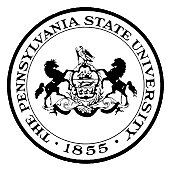
This history of Penn State is an exciting and important document. It chronicles the founding and growth of an institution from its identity as The Farmer's High School in 1855 to its current status as The Pennsylvania State University, an institution encompassing twenty-two locations across the Commonwealth.
Penn State provides access to higher education that is within thirty miles of 90 percent of Pennsylvania's citizens and serves over 61,000 credit students and 120,000 non-credit students annually. For the 1984-85 academic year, the University attracted approximately S107 million in organized research. It operates Cooperative Extension programs that serve agriculture, rural life, and agri-business in all of Pennsylvania's sixty-seven counties and, in addition, reaches annually more than 100,000 students through Penn State's Division of Continuing Education.
A university with such an exemplary record of service to its constituencies is, of course, the lengthened shadow of great men and women. It is the result of notable efforts by a line of presidents, trustees, faculty, staff, and alumni who have fostered the well-being of this remarkable institution. Beyond such historic contributions of individuals, it must be remembered that Penn State could not have progressed as it has without the support of committed elected officials in the state and federal government who have had the vision and courage to invest public funds in higher education as a means of preparing our young people for the responsibilities they inevitably inherit.
Penn State graduates have made their mark in all phases of American life. Our alumni head more than a dozen Fortune 500 companies. They include the co-winner of the 1980 Nobel prize in chemistry; the chief of NASA's space shuttle operations; the first black astronaut to fly in space; the head of the National Weather Service; the director of the renowned Center for Advanced Study in the Behavioral Sciences; the national editors of the New York Times and the Los Angeles Times; and the executive editor of Ebony. The University counts among its graduates dedicated teachers, farmers, physicians, lawyers, artists, elected officials, scientists and others who are, as Milton Eisenhower once noted, "the real interpreters of the University to the people of the Commonwealth and the nation." Their achievements give Penn State its purpose and its aspirations. This history chronicles the trials and triumphs encountered in the building of an academic institution that is dedicated to helping its students reach their highest goals.
Bryce Jordan, President
The Pennsylvania State University